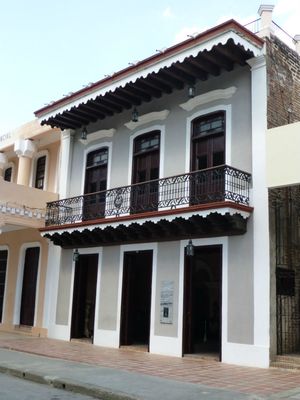

Casa Natal de Carlos Manuel de Céspedes Birth House, Bayamo
Visit the birth house-museum of the Father of the Nation and admire the only two-roof colonial house which is still perfectly preserved in Bayamo.
The museum, located in the building when the Father of the Nation was born in 1819, Carlos Manuel de Céspedes, hosts on its inside collections related to the 1868 revolution or with Céspedes’ life.
In relation to the architectonic structure of the dwelling, the first level of the construction dates from the 18th century and has the shape of a ‘C’. You access the inside through three high wooden doors, opening to the main saloon.
The inside gallery is supported by seven Tuscan pilasters which go all over the courtyard, where you can see the beautiful Neo-Classical fountain, a statuette and two marble benches, among the most relevant things.
To go up to the second level, designed in 1833, it was made a staircase of mahogany with two branches, very robust and steady, decorated with a banister and a handrail. The upper floor has friezes painted in different tonalities on the walls, as well as moldings and scotias.
You can access to the balcony built on the second floor, where it is distinguished engraved in the iron the year of its building and the surnames of the artist as well as the owner of the building. In general, although it was built in two different ages, it has a mainly Mudejar style.
After different owners and uses, among them as Post Office, it passed to the hands of the Cuban Government in 1959. In 1962 it was definitely closed because it was very deteriorated and three years later began its restoration to be opened as museum in 1968. In 1978 it was officially declared National Monument.
The museum focuses essentially in the life and work of Céspedes. There is also a department of methodology and bibliography counsel for students, researchers and those interested in the culture and history related to this important historical character.
The exhibition is spread in eleven room. The first 8, focused in the life of Céspedes and his family, are organized in the lower floor and the other three are located in the upper one, reproducing the affluent people’s environment of a family of the end of the 19th century beginning of the 20th; along with two nineteenth-century visitable kitchens and another three rooms for offices which are intended to, in a future, be added to the museum.
In addition to be the home of Céspedes for his 12 first years of life, the house has also architecture value since it is the only two-roof Colonial house still standing in Bayamo and one of the few buildings which survived the 1869 fire. In this line, it should be emphasized that the museum was awarded in 2014 with the Maintenance National Prize.
Do not hesitate in visiting this beautiful historical monument located in the center of the city of Bayamo. Before you visit the museum it is recommendable to make a call to reassure the opening hours and the ticket price, since they can be changed without previously notice.
More information:
Location:
Calle Antonio Maceo 57 e/ Mármol y José Joaquín Palma, Bayamo. Granma, Cuba.
Opening hours:
From Tuesday to Friday from 9:00 a.m. to 5:00 p.m.
Saturday from 9:00 a.m. to 2:00 p.m.
Sunday from 10:00 a.m. to 1:00 p.m.
Telephone:
+53 423 864.
Webpage:
http://www.crisol.cult.cu/otros/paseo_cespedes/
Interactive map:
Granma
What to see:
- Bayamo
- Céspedes Park
- San Salvador Major Parish Church
- Paseo Bayamés Promenade
- Ventana de Luz Vázquez Window
- Casa de Estrada Palma House
- San Juan Evangelista Tower
- Cupaynicú Botanic Garden
- Dos Ríos
- Sierra Maestra Range Great National Park
- Comandancia General de La Plata High Command
- Santo Domingo
- Manzanillo
- Céspedes Park
- Iglesia de la Purísima Concepción Church
- Manzanillo Theater
- Niquero
- Alegría del Pío
- Desembarco del Granma National Park
- Cabo Cruz
- El Guafe Natural Archaeological Trail
- Pilón
Beaches:
Museums:
Other nearby destinations:
Why "Trip Cuba"?
Trip Cuba is an organization of Cuban agencies whose objectives are:
- ✓ To make Cuba, its culture and its heritage known.
- ✓ To promote sustainable tourism.
- ✓ To support the local economy, prioritizing direct contact with Cuban agencies.
Travel Agencies
If you are a travel agency or tour operator and you are looking forward to any assistance or collaboration to plan trips to Cuba, rely on our extensive experience
Copyright www.TripCuba.Org © - All rights reserved
All our agencies are duly registered in the National Registry of Travel Agencies of the Chamber of Commerce of the Republic of Cuba.







